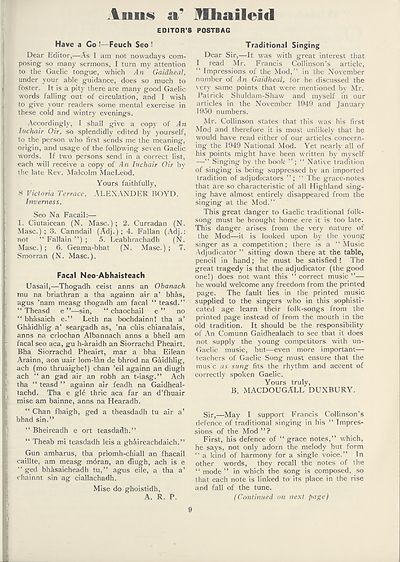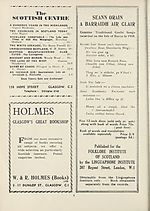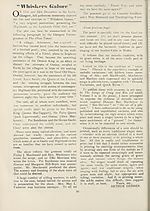An Comunn Gàidhealach Publications > Gaidheal > Volumes 46--48, January 1951--December 1953
(19) Page 9
Download files
Complete book:
Individual page:
Thumbnail gallery: Grid view | List view

Anns a" Hhaileid
EDITOR'S POSTBAG
Have a Co !—Feuch Seo!
Dear Editor,—As I am not nowadays com¬
posing so many sermons, I turn my attention
to the Gaelic tongue, which An Gaidheal,
under your able guidance, does so much to
foster. It is a pity there are many good Gaelic
words falling out of circulation, and I wish
to give your readers some mental exercise in
these cold and wintry evenings.
Accordingly, I shall give a copy of An
luchair Oir, so splendidly edited by yourself,
to the person who first sends me the meaning,
■origin, and usage of the following seven Gaelic
words. If two persons send in a correct list,
each will receive a copy of An luchair Oir by
the late Rev. Malcolm MacLeod.
Yours faithfully,
8 Victoria Terrace, ALEXANDER BOYD.
Inverness,
Seo Na Facail:—
1. Ciutaicean (N. Masc.); 2. Curradan (N.
Masc.) ; 3. Canndail (Adj.); 4. Fallan (Adj.:
not “ Fallain ”) ; 5. Leabhrachadh (N.
Masc.); 6. Geama-bhat (N. Masc.); 7.
Smorran (N. Masc.).
Facal Neo Abhaisteach
Uasail,—Thogadh ceist anns an Obanach
mu na briathran a tha againn air a’ bhks,
agus 'nam measg thogadh am facal “ teasd.”
“ Theasd e ”—sin, “ chaochail e ” no
“ bhhsaich e.” Leth na bochdainn! tha a’
Gh&idhlig a’ seargadh as, ’na ciiis chianalais,
anns na criochan Albannach anns a bheil am
facal seo aca, gu h-kraidh an Siorrachd Pheairt.
Bha Siorrachd Pheairt, mar a bha Eilean
Arainn, aon uair lom-lkn de bhrod na Gkidhlig,
ach (mo thruaighe!) chan ’eil againn an diugh
ach “ an gad air an robh an t-iasg.” Ach
tha “ teasd ” againn air feadh na Gaidheal-
tachd. Tha e gl6 thric aca far an d’fhuair
mise am bainne, anns na Hearadh.
“ Chan fhaigh, ged a theasdadh tu air a’
bhad sin.”
“ Bheireadh e ort teasdadh.”
“ Theab mi teasdadh leis a ghkireachdaich.”
Gun amharus, tha prlomh-chiall an fhacail
caillte, am measg mdran, an diugh, ach is e
” ged bhksaicheadh tu,” agus eile, a tha a’
chainnt sin ag ciallachadh.
Mise do ghoistidh,
A. R. P.
Traditional Singing
Dear Sir,—It was with great interest that
I read Mr. Francis Collinson’s article,
“ Impressions of the Mod,” in the November
number oi An Gaidheal, for he discussed the
very same points that were mentioned bv Mr.
Patrick Shuldam-Shaw and myself in our
articles in the November 1949 and January
1950 numbers.
Mr. Collinson states that this was his first
Mod and therefore it is most unlikely that he
would have read either of our articles concern¬
ing the 1949 National Mod. Yet nearly all of
his points might have been written by myself
—Singing by the book ” ; ” Native tradition
of singing is being suppressed by an imported
tradition of adjudicators ”; ” The grace-notes
that are so characteristic of all Highland sing¬
ing have almost entirely disappeared from the
singing at the Mod.”
This great danger to Gaelic traditional folk¬
song must be brought home ere it is too late.
This danger arises from the very nature of
the Mod—it is looked upon by the young
singer as a competition; there is a ‘‘Music
Adjudicator ” sitting down there at the table,
pencil in hand; he must be satisfied ! The
great tragedy is that the adjudicator (the good
one!) does not want this ‘‘correct music ”—
he would welcome any freedom from the printed
page. The fault lies in the printed music
supplied to the singers who in this sophisti¬
cated age learn their folk-songs from the
printed page instead of from the mouth in the
old tradition. It should be the responsibility
of An Comunn Gaidhealach to see that it does
not supply the young competitors with un-
Gaelic music, but—even more important—
teachers of Gaelic Song must ensure that the
mus e as sung fits the rhythm and accent of
correctly spoken Gaelic.
Yours truly,
B. MACDOUGALL DUXBURY.
Sir,—May I support Francis Collinson’s
defence of traditional singing in his “ Impres¬
sions of the Mod ”?
First, his defence of “ grace notes,” which,
he says, not only adorn the melody but form
“ a kind of harmony for a single voice.” In
other words, they recall the notes of the
‘‘ mode ” in which the song is composed, so
that each note is linked to its place in the rise
and fall of the tune.
(Continued on next page)
EDITOR'S POSTBAG
Have a Co !—Feuch Seo!
Dear Editor,—As I am not nowadays com¬
posing so many sermons, I turn my attention
to the Gaelic tongue, which An Gaidheal,
under your able guidance, does so much to
foster. It is a pity there are many good Gaelic
words falling out of circulation, and I wish
to give your readers some mental exercise in
these cold and wintry evenings.
Accordingly, I shall give a copy of An
luchair Oir, so splendidly edited by yourself,
to the person who first sends me the meaning,
■origin, and usage of the following seven Gaelic
words. If two persons send in a correct list,
each will receive a copy of An luchair Oir by
the late Rev. Malcolm MacLeod.
Yours faithfully,
8 Victoria Terrace, ALEXANDER BOYD.
Inverness,
Seo Na Facail:—
1. Ciutaicean (N. Masc.); 2. Curradan (N.
Masc.) ; 3. Canndail (Adj.); 4. Fallan (Adj.:
not “ Fallain ”) ; 5. Leabhrachadh (N.
Masc.); 6. Geama-bhat (N. Masc.); 7.
Smorran (N. Masc.).
Facal Neo Abhaisteach
Uasail,—Thogadh ceist anns an Obanach
mu na briathran a tha againn air a’ bhks,
agus 'nam measg thogadh am facal “ teasd.”
“ Theasd e ”—sin, “ chaochail e ” no
“ bhhsaich e.” Leth na bochdainn! tha a’
Gh&idhlig a’ seargadh as, ’na ciiis chianalais,
anns na criochan Albannach anns a bheil am
facal seo aca, gu h-kraidh an Siorrachd Pheairt.
Bha Siorrachd Pheairt, mar a bha Eilean
Arainn, aon uair lom-lkn de bhrod na Gkidhlig,
ach (mo thruaighe!) chan ’eil againn an diugh
ach “ an gad air an robh an t-iasg.” Ach
tha “ teasd ” againn air feadh na Gaidheal-
tachd. Tha e gl6 thric aca far an d’fhuair
mise am bainne, anns na Hearadh.
“ Chan fhaigh, ged a theasdadh tu air a’
bhad sin.”
“ Bheireadh e ort teasdadh.”
“ Theab mi teasdadh leis a ghkireachdaich.”
Gun amharus, tha prlomh-chiall an fhacail
caillte, am measg mdran, an diugh, ach is e
” ged bhksaicheadh tu,” agus eile, a tha a’
chainnt sin ag ciallachadh.
Mise do ghoistidh,
A. R. P.
Traditional Singing
Dear Sir,—It was with great interest that
I read Mr. Francis Collinson’s article,
“ Impressions of the Mod,” in the November
number oi An Gaidheal, for he discussed the
very same points that were mentioned bv Mr.
Patrick Shuldam-Shaw and myself in our
articles in the November 1949 and January
1950 numbers.
Mr. Collinson states that this was his first
Mod and therefore it is most unlikely that he
would have read either of our articles concern¬
ing the 1949 National Mod. Yet nearly all of
his points might have been written by myself
—Singing by the book ” ; ” Native tradition
of singing is being suppressed by an imported
tradition of adjudicators ”; ” The grace-notes
that are so characteristic of all Highland sing¬
ing have almost entirely disappeared from the
singing at the Mod.”
This great danger to Gaelic traditional folk¬
song must be brought home ere it is too late.
This danger arises from the very nature of
the Mod—it is looked upon by the young
singer as a competition; there is a ‘‘Music
Adjudicator ” sitting down there at the table,
pencil in hand; he must be satisfied ! The
great tragedy is that the adjudicator (the good
one!) does not want this ‘‘correct music ”—
he would welcome any freedom from the printed
page. The fault lies in the printed music
supplied to the singers who in this sophisti¬
cated age learn their folk-songs from the
printed page instead of from the mouth in the
old tradition. It should be the responsibility
of An Comunn Gaidhealach to see that it does
not supply the young competitors with un-
Gaelic music, but—even more important—
teachers of Gaelic Song must ensure that the
mus e as sung fits the rhythm and accent of
correctly spoken Gaelic.
Yours truly,
B. MACDOUGALL DUXBURY.
Sir,—May I support Francis Collinson’s
defence of traditional singing in his “ Impres¬
sions of the Mod ”?
First, his defence of “ grace notes,” which,
he says, not only adorn the melody but form
“ a kind of harmony for a single voice.” In
other words, they recall the notes of the
‘‘ mode ” in which the song is composed, so
that each note is linked to its place in the rise
and fall of the tune.
(Continued on next page)
Set display mode to:
![]() Universal Viewer |
Universal Viewer | ![]() Mirador |
Large image | Transcription
Mirador |
Large image | Transcription
| An Comunn Gàidhealach > An Comunn Gàidhealach Publications > Gaidheal > Volumes 46--48, January 1951--December 1953 > (19) Page 9 |
|---|
| Permanent URL | https://digital.nls.uk/127503901 |
|---|
| Description | This contains items published by An Comunn, which are not specifically Mòd-related. It includes journals, annual reports and corporate documents, policy statements, educational resources and published plays and literature. It is arranged alphabetically by title. |
|---|
| Description | A collection of over 400 items published by An Comunn Gàidhealach, the organisation which promotes Gaelic language and culture and organises the Royal National Mòd. Dating from 1891 up to the present day, the collection includes journals and newspapers, annual reports, educational materials, national Mòd programmes, published Mòd literature and music. |
|---|---|
| Additional NLS resources: |
|

